JRD TATA MEMORIAL LECTURE AT BANGALORE
20-08-2005 : Bangalore
VISION FOR AERONAUTICS MISSIONS
I am indeed delighted to deliver the JRD Tata Memorial Lecture in this beautiful environment. It gives me immense pleasure to be amongst the members of National Institute of Advanced Studies, Scientists, Engineers, Technologists and Academicians. My greetings to all of you. I was thinking what thoughts I can share with you when we are remembering a great visionary JRD Tata, who has contributed for the growth of aeronautics in this country.
Aviation Profile
Human flight is nothing but creativity of human mind and it come after several struggles to achieve excellence. In 1892, a great well-known scientist Lord Kelvin, who was the President of Royal Society of London said, "any thing heavier than air cannot fly, and cannot be flown." In 1903, Wright Brothers demonstrated that man could fly, disproving Kelvin. In India, JRD Tata was the first visionary leader who started aviation. On October 15, 1932, the first flight of Indian Civil aviation took place from Karachi to Ahmedabad and on to Bombay. His efforts led to the birth of Air India in 1946. Let
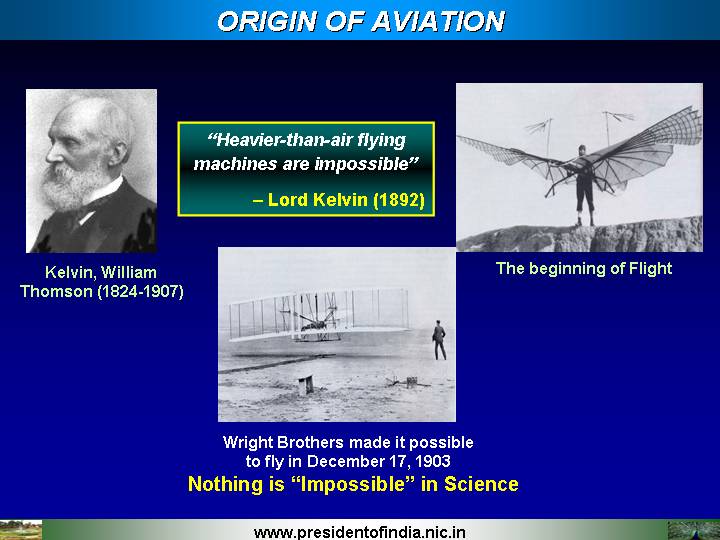
us recall his word "with Air India, I was creating something new, something entirely new, and therefore I was creating history in a small way so did not have to have the responsibility for the past".
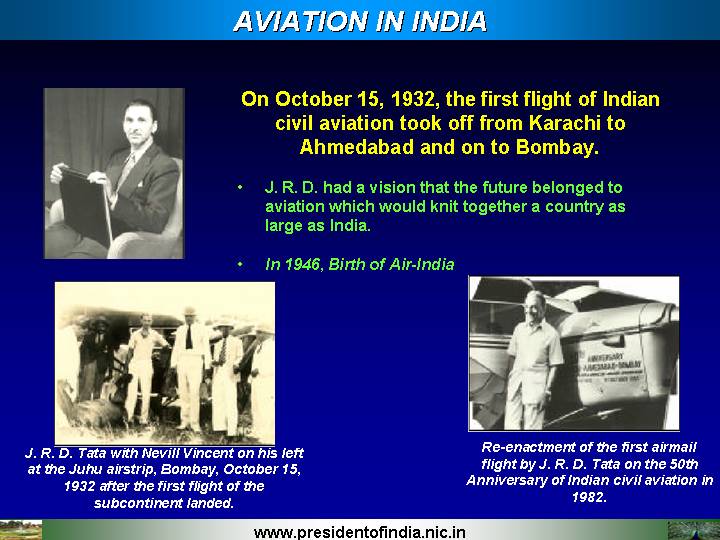
We can see how a creative mind blossomed the aviation in India. How that vision of aeronautics can take a real shape now? The need today is for the design, development, production and marketing of an Indian made 150 seater passenger jet. LCA has been successfully flight tested and is going to production phase. ALH is in production and is entering the export market. Advanced Satellite Launch Vehicles such as PSLV and GSLV are being made in the country. Strategic missiles with re-entry technology and supersonic cruise missiles are operational. With these strengths India definitely has the ability to design, develop and operationalize state of the art passenger jets in a most cost effective manner.
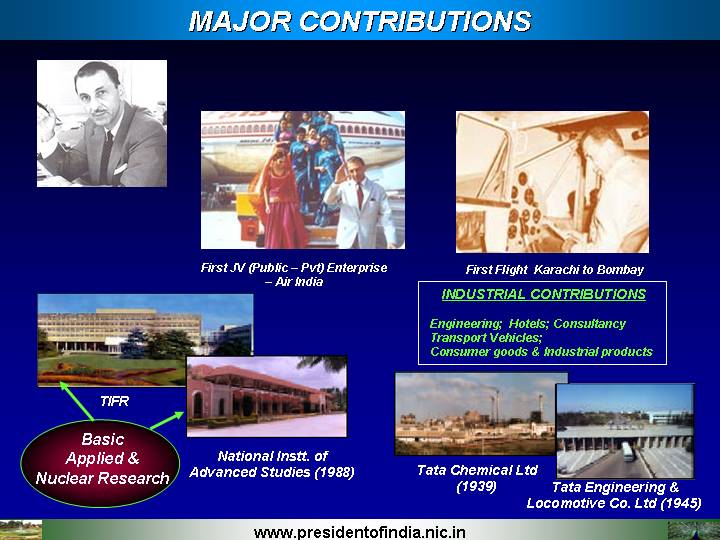

Aerospace Today
India during the last 40 years has progressed tremendously in space, missiles and multiple aircraft programmes. From the successful launching of SLV-3 in July 1980, India steadily progressed to operational capabilities with PSLV and GSLV for Remote Sensing and Communication satellites. India is self-reliant in space technology and can offer competitive launch service. The fruit of space research has started reaching the people enabling development of the nation.
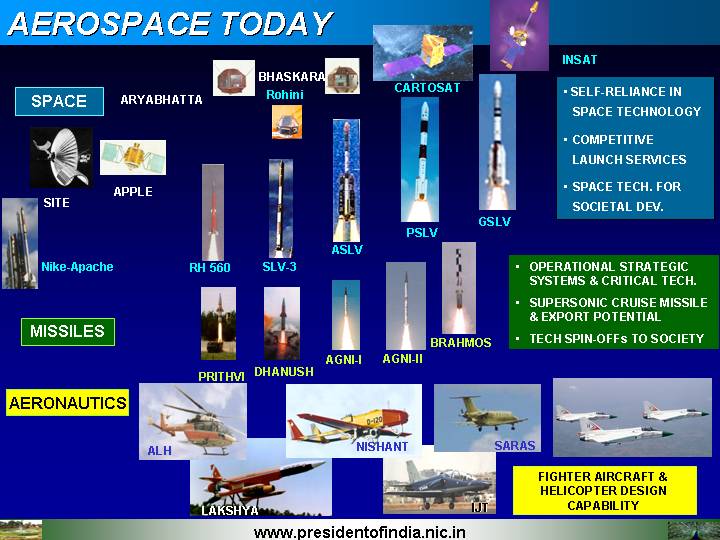
In the missile programme, Prithvi and Agni are
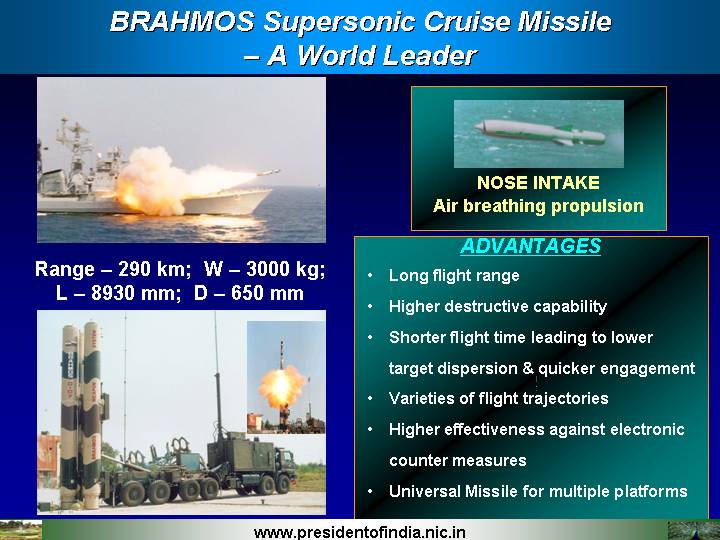
operational. The development of NAG, a third generation anti tank missile is a breakthrough in seeker technology with fire and forget capability. The emergence of BRAHMOS ? an Indo-Russian joint venture Supersonic Cruise Missile is a break-through to obtain a unique capability for long-range precision strike. The missile programme has given strength to the nation and BrahMos has demonstrated its world leadership and the availability for export.
NAL flight-tested the 14 seater SARAS and HAL has successfully productionized the Advanced Light Helicopter (ALH). The ALH is a unique multi-role, state-of-the-art, cost effective helicopter and will be a workhorse of the Indian aviation in the coming years. DRDO's Lakshya and Nishant are unmanned aerial vehicles and are in production. SU-30 MK's avionics and MiG series of aircraft upgradation are being done in India and this is a testimony of the nation?s capabilities in advanced aircraft systems. India has achieved core competencies in the design and development capability of aeronautical systems such as military aircraft and helicopters as well as aerospace systems such as launch vehicles and satellites. This all around capability of design and development of airborne systems is an adequate foundation for us to build on to develop our own 150 seater passenger jet.
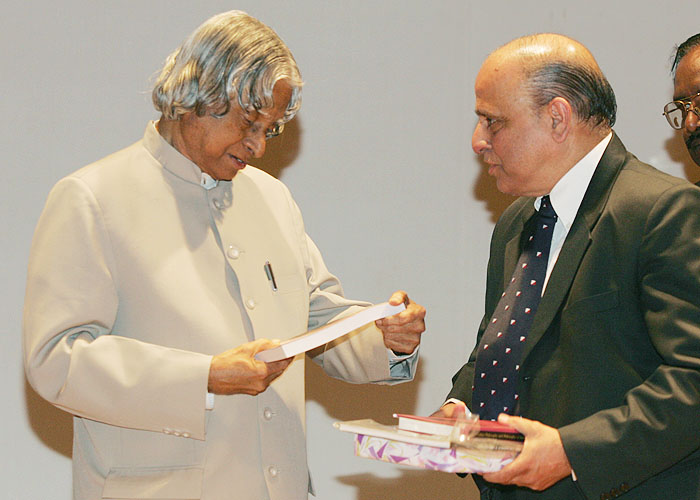

Aerospace Technologies
For the aeronautical community, the real major
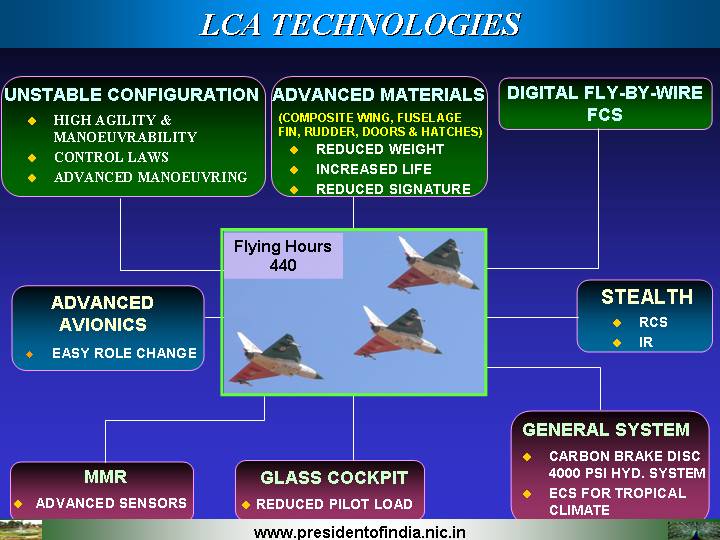
milestone was the successful demonstration flight of the first prototype Light Combat Aircraft (LCA) designed and developed by ADA. On the whole, aerospace systems programme of India achieved a significant progress. Due to various aerospace programmes, multiple state-of-the-art technologies got developed. Computational Fluid Dynamics (CFD) emerged as core strength for India with advanced software codes and super computing capability to optimize configurations for guided missiles, LCA and launch vehicles. CAD/CAM has become a critical tool in Aerospace systems design and manufacturing. In addition, ADA has established unique
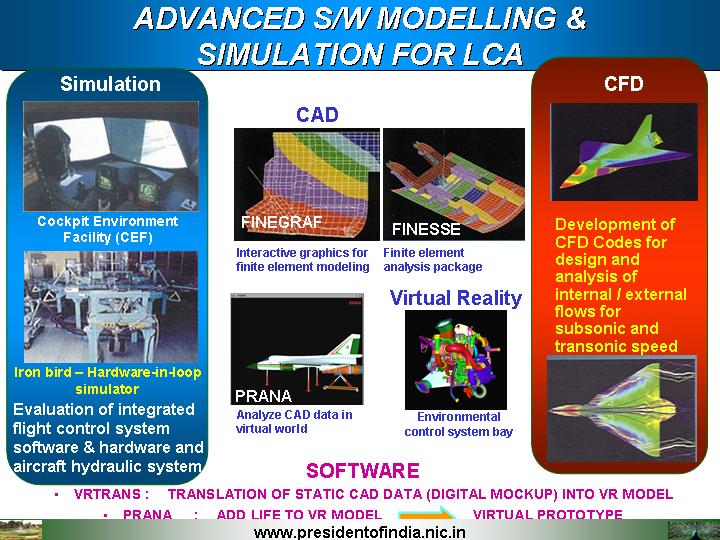
software capability for virtual reality, which reduces the design and product realization time by 40%. ADA and HAL have automated the design to manufacturing life cycle process with the extensive usage of digital documentation and processing. This important capability heralds the Indian Aerospace industry into levels of maturity of capability that are comparable to the very best aircraft manufacturing facilities available in the developed countries.
In the composite technology, the Carbon-Carbon nose tip of Agni and high temperature Radomes and large composite wing of LCA show the strength of the country in the composite
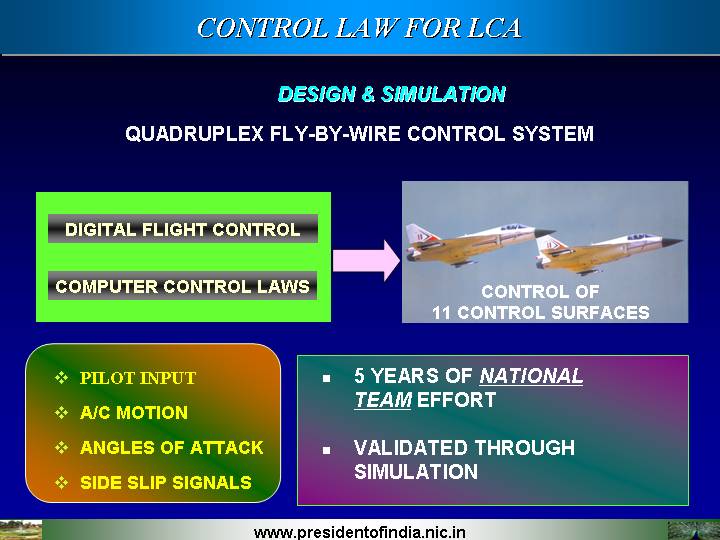
products. The Digital Fly-by-Wire control system and the control laws developed for LCA with the formation of national team, made the aircraft state-of-the-art. With the above technologies and the engine development in progress, the next generation medium combat aircraft is bound to take shape.
Technology Vision 2020 - Passenger Aircraft
A study undertaken by the committee of experts on India?s vision 2020 has come out with a large potential for possible aircraft to be produced in India. The Technology Vision 2020 has estimated that in the Indian market, taking into account the fastest growing Indian aviation and opening up of Indian aviation to private sector, there is a demand for
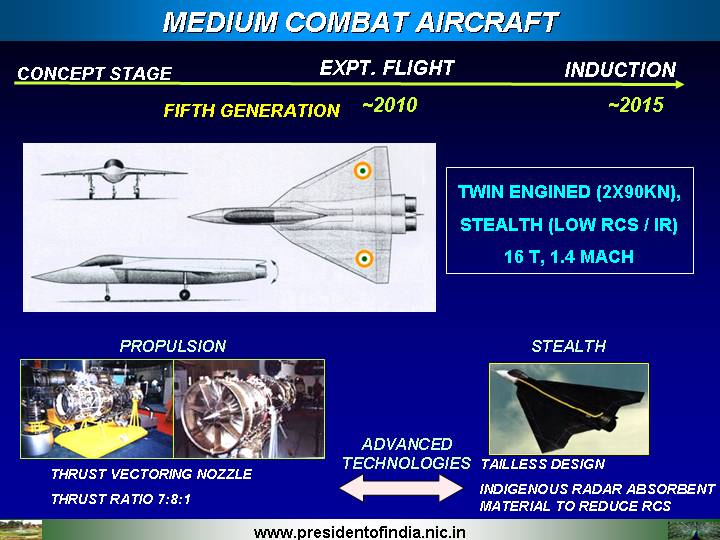
around 60 nos. of 300+ seater aircraft, around 30 nos. of 200+ seater aircraft, around 70 nos. of 150+ seater aircraft and around 65 nos of 100+ seater aircraft. Similarly, in the export market, there is demand of about 280 nos for 100+ seater aircraft. From the findings, it has been concluded that it will be economically viable to produce a 150 seater aircraft in India. What is needed is to integrate the strength available in the country in a mission mode. With technology partnership between aerospace industries and Academic institutions the Indian made passenger aircraft will become a reality.
The development of passenger aircraft call for many
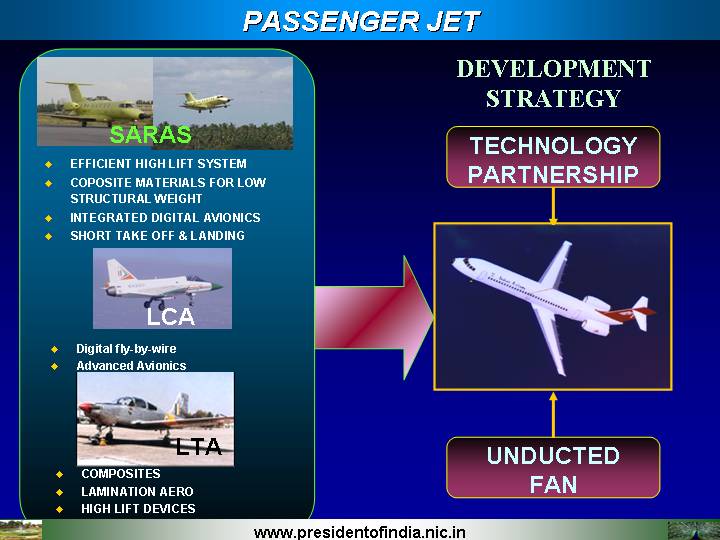
complex technologies to be mastered. For example, the improvement of fuel efficiency using unducted Fan is a great challenge. Identifying international collaborators and partners for joint development of many appropriate technologies at the initial phase itself would be required. This will also increase the potential for marketing in the international scene as well.
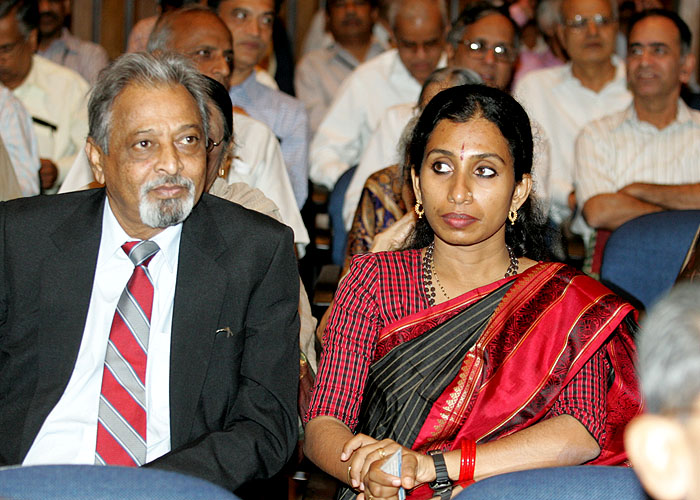

Hypersonic Reusable Vehicles
Hypersonic reusable missile is an emerging area to achieve greater speeds using Ramjet and Scramjet engine. A study has been presently carried out for an air launched reusable hypersonic missile flying at an altitude of 30-40 km.
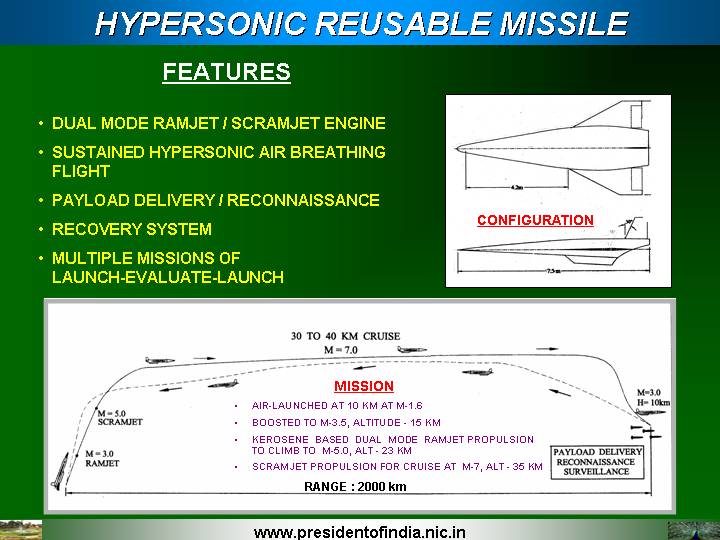
in cruise mode at mach 7 to a range of 2000 km and fly back to the launch point.
This type of missions will be highly useful for multiple applications. In the case of Hyperplane, the aim was to achieve larger payload fraction. The space shuttle of USA with 2000 tonnes take off weight could launch only 30 tonnes in low earth orbit, giving a payload fraction of 1.5%. India?s concept of Hyperplane aims to realise 15% of payload fraction. This will considerably reduce the launch cost per mission and will enable multiple missions such as transport, reconnaissance, payload delivery, satellite injection etc. A typical mission of Hyperplane takes off with 100 tonnes weight
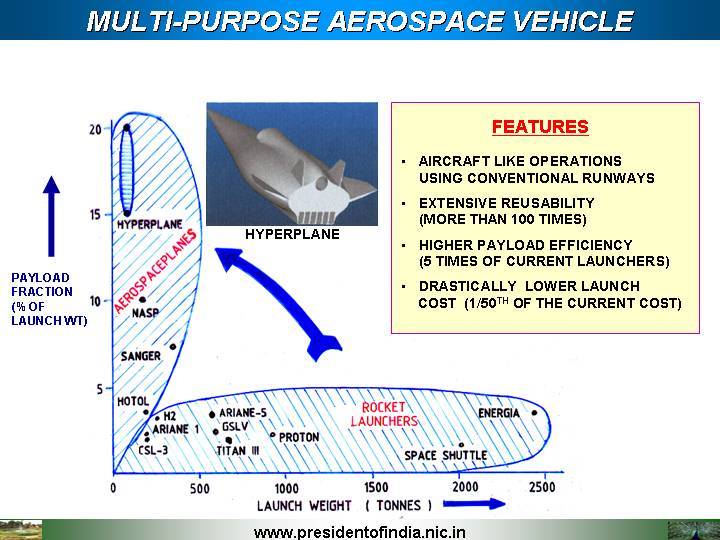
using fan ramjet engine, works on scramjet mode for nearly 1000 sec. during which time it collects the left over air, cools it and separates as liquid oxygen. This increases its weight to 166 tonnes, thereafter it flies in rocket engine mode using the liquid oxygen and stored liquid Hydrogen to deliver a payload of 15-16 tonnes.
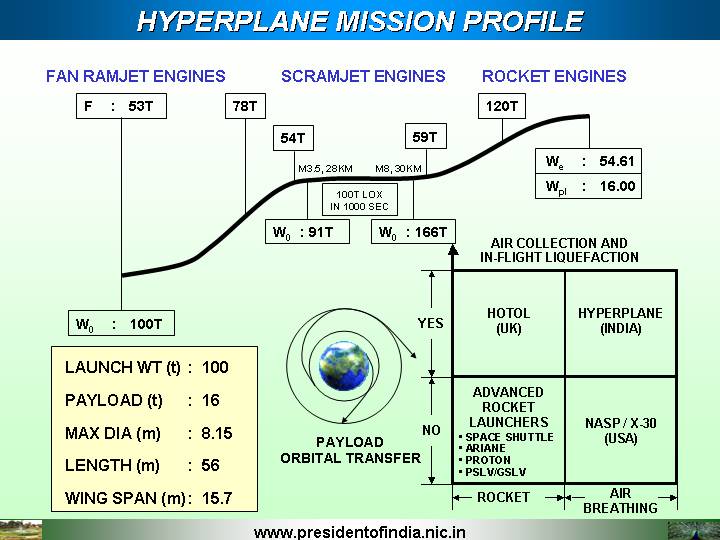
This concept of mass addition in flight is unique and conceived by Indian scientists. Hypersonic Technologies include scramjet propulsion, air
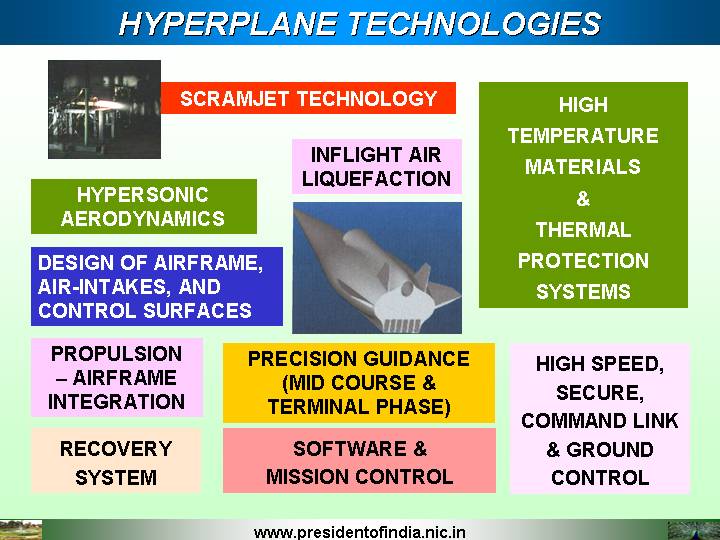
liquefaction, high temperature materials, guidance control and software package.

Emerging Aircraft
Prof Satish Dhawan ? a teacher of aeronautics and designer visualized morphing airframes for the aircraft to fly like a bird flapping its wings. He in his own handwriting plotted egrat?s take-off in million seconds and dreamt that aeronautics designers will one day come out with an aircraft to fly like a bird. Will advancement in MEMS and nano technology with new materials, flexibility in engineering,
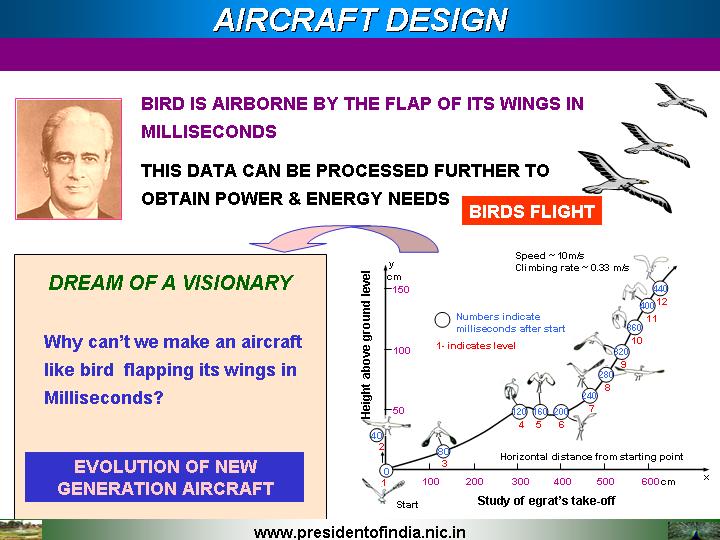
intelligent machines and software, the dream of the visionary will come true.
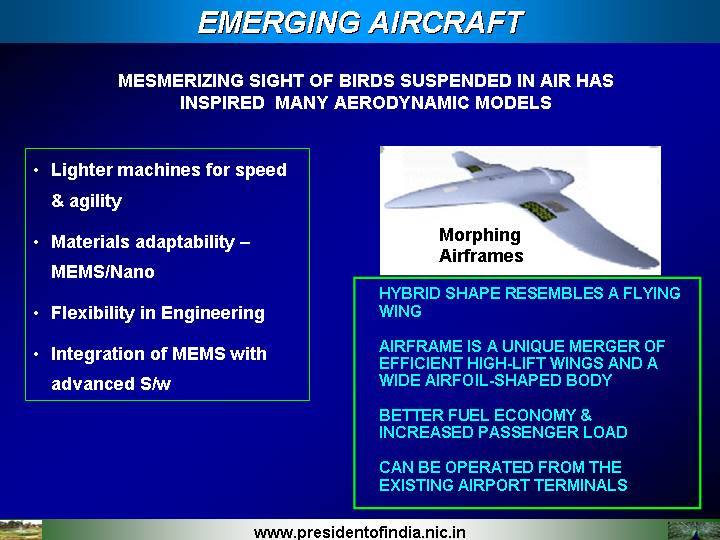

National Aerospace Policy ? Need of the hour
Space systems, missile and aeronautics groups have demonstrated technology excellence in their products through
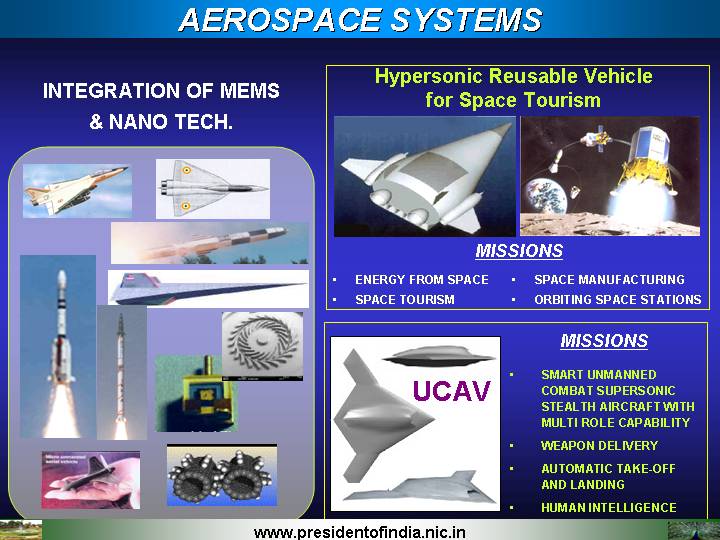
networking with academic institutes, industries and government. There are more than three hundred thousand engineers and technicians with infrastructure of more than Rs.20,000 Cr. There is strong mission management culture and committed partnership. With this national strength and opportunity for larger demand in aerospace systems and export potential, a large business for industries is in front of us. It is essential that this strength is integrated into a National Aeronautics Policy for integrating the strengths of both civil and military aviation sectors to bring synergy in the
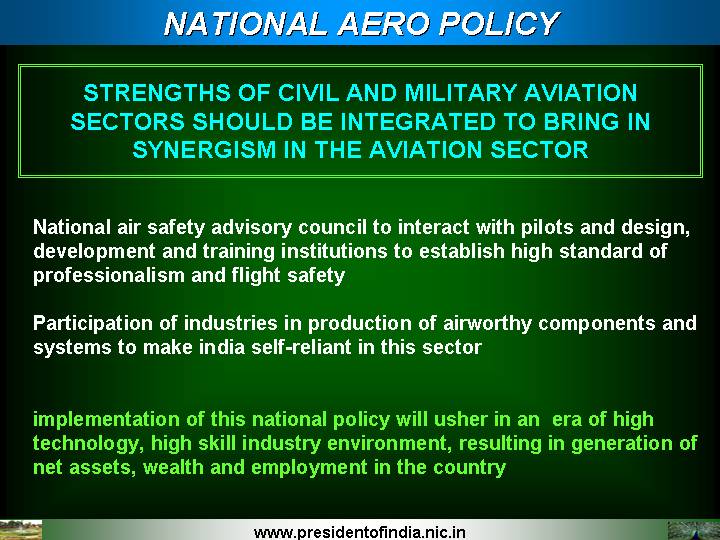
aviation sector. Implementation of this policy will usher in era of high technology and high skill industry environment resulting generation of assets, wealth and employment in the country.

Aerospace Missions & Applications ? A perspective
Beyond 2020, the aerospace world will enter into space industry and space tourism, mining in planets and space habitats. Hypersonic reusable vehicles will offer cost effective transportation for the space missions. With the increasing demand of electric power, many nations will depend on Solar Power Satellite (SPS) which could be built in space and
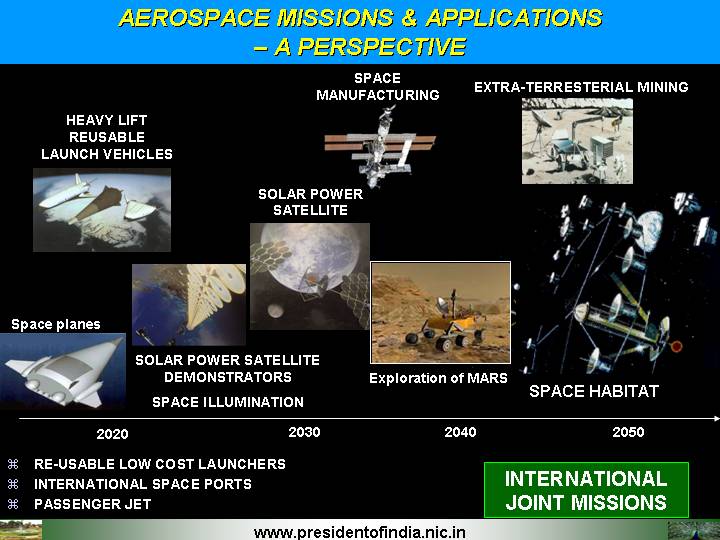
launched in geo-stationary orbit. The SPS will become the most cost effective means of generating power. Factories in moon and establishment of space habitat at L4/L5 liberation points will become the missions.
Aerospace Education and Research in India
In the 70's and the 80's the challenges thrown by the nation?s desire to achieve self-sufficiency in aeronautical and aerospace arena had been the reason for the growth of aerospace education and research in the country. Several innovative programmes and highly acclaimed departments in many universities, IITs and IISc started blossoming and flourishing. This was also the time period at which the programme for satellite and launch vehicles development and programmes such as LCA, ALH and IGMDP had been the most visible national initiatives. At that time, the Aerospace had also been a hard engineering subject. Today aerospace and aeronautics encompass many emerging areas such as software, material science, control and guidance, and computers and communication technologies. This multi-disciplinary area can only be developed by uniting many minds working in diverse areas. One such vehicle that would unite the alert minds is a National Vision like IGMDP, LCA or ALH. Looking at the current scenario, the mission mode approach to develop 150 seater passenger aircraft would be technologically satisfying enough to attract youngsters to take to aeronautical education and research, would make economic sense and at the same time meet the national requirements.
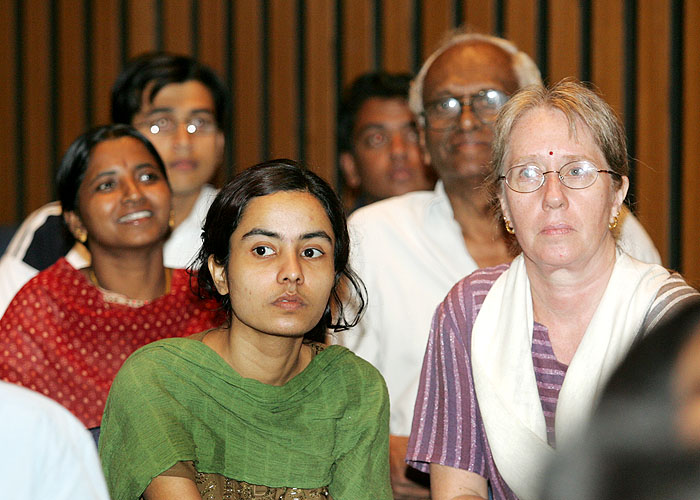

Conclusion
Technologies in the field of aeronautics, space and missile are converging. This convergence will lead to a cost effective high quality design, development and production of the various types of aerospace systems such as:
(a) 150 seater passenger jet
(b) Supersonic unmanned combat aircraft
(c) hypersonic reusable missile
(d) hyperplane
(e) Planetary missions including manned missions for energy and water.
With vast infrastructure and human resource in the aerospace sector India definitely can launch such missions with international partnership.
Nuclear reactors to produce electric power have come out of Atomic Energy Commission, Launch Vehicles and Satellites have come out of Space Commission, Strategic missiles have come out of empowered Guided Missile Board. Definitely, a National Aeronautics Commission should be planned and should be given the mandate to design, develop and send it soaring in the Indian skies, a passenger aircraft. When our 150 seater aircraft flies, in our sky, JRD will smile.
May God bless you.
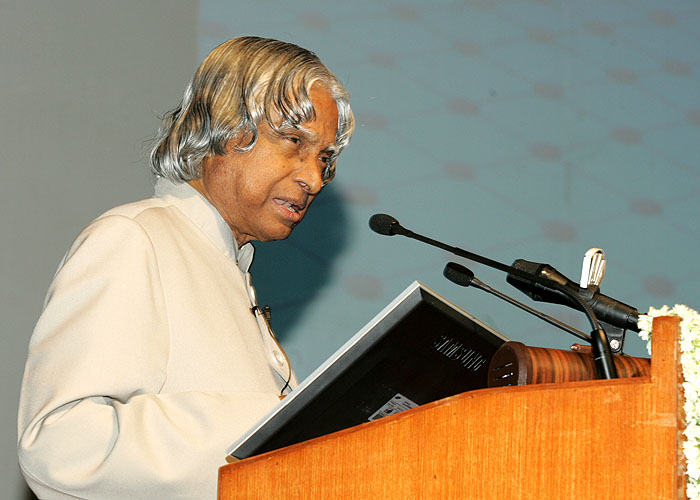
<<Back
|